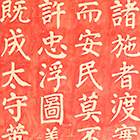Asian Gallery (Toyokan) Room 8
December 3, 2013 (Tue) - February 2, 2014 (Sun)
In China, calligraphic techniques reached their zenith during the Tang dynasty (618-907) and Eastern Jin dynasty (317-420). A characteristic of Tang-dynasty calligraphy is that techniques that had developed ever since the work of 4th-century calligrapher Wang Xizhi were defined and codified. Works by Yu Shinan, Ouyang Xun, Chu Suiliang and Yan Zhenqing (709-785), who are called the four greatest calligraphers of the Tang dynasty, are still studied as classics of calligraphy. In particular, Yan Zhenqing, while basing his work on traditional techniques, created a distinctive brushwork style known as "silkworms' heads and swallows' tails (cantou yanwei)." His style attracted many admirers and influenced later generations.
In contrast to the aristocratic culture of the Tang dynasty, in the Song dynasty (960-1279), scholar-bureaucrats (officials who had passed higher civil service exams) led the way in scholarship and art. Calligraphic expressions also changed drastically. Features of Song-dynasty calligraphy are a strong regard for the individual as well as expressions that highly praise human nature. Of the four greatest calligraphers of the Song dynasty, Su Shi, Huang Tingjian and Mi Fu were all preeminent. However, it was Cai Xiang (1012-1067) who preceded them and really determined the direction of Song-dynasty calligraphy. Inheriting traditional calligraphic techniques, Cai was strongly influenced by Yan Zhenqing. Cai also represented a bridge connecting calligraphy at the end of the Tang dynasty and Five Dynasties period (907-960) to calligraphy in the Northern Song dynasty (960-1127).
This exhibition includes Album of Court Appointments in Regular Script by Yan Zhenqing, and Verse in Gratitude for a Gift of Imperial Calligraphy in Regular Script by Cai Xiang, which are famous works on loan from Taito City Calligraphy Museum. Focusing on these two works, this exhibition highlights characteristics of Tang- and Song-dynasty calligraphy.

